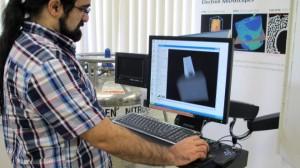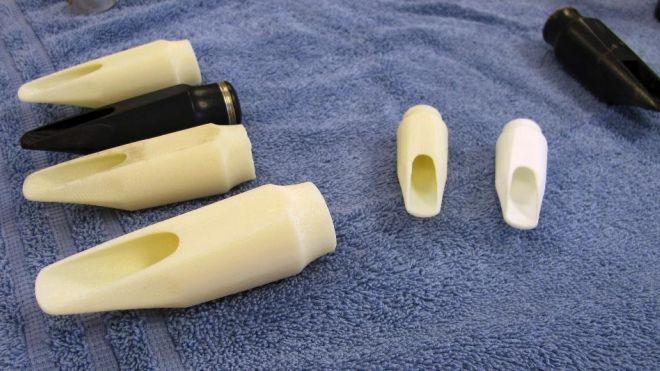
Sina Shahbazmohamadi, an engineer and the University of Connecticut’s director for advanced 3D imaging, looks at a CT scan at UConn’s Depot Campus in Mansfield, Conn., showing a mouthpiece for a 19th-century saxophone built by inventor Adolphe Sax. Researchers at the school are using CT scanning and 3D printing to study and reproduce antique musical instruments. (AP Photo/Pat Eaton-Robb) (THE ASSOCIATED PRESS)
Researchers from the University of Connecticut are using 3D printing to bring antique instruments back to life. After seeing 3D imaging in action at his medical practice, Dr. Robert Howe, a reproductive endocrinologist, thought it would be a great idea to apply the technology to antique instrumentation.
Howe, who is a doctoral student in music theory and history at UConn, told his music history professor his idea. The professor, Richard Bass, thought it was worth a shot, so he contacted his colleague, Sina Shahbazmohamadi, UConn’s director of advanced 3D imaging, for assistance. Working together, Shahbazmohamadi, Howe and Bass came up with a viable process. The process, which the UConn researchers are trying to patent, allowed them to create 3D images of antique instruments and print working versions of them using 3D printers.
Before the UConn researcher’s process, making copies of antique instruments was expensive and time-consuming. To make replacement parts, for example, an artisan would have had to measure the part that needed to be replaced by hand with calipers and other instruments, which could damage and mark-up the antique instrument. Then those measurements would have to have been used to try to recreate the part.
One of the instruments that the UConn team was able to reproduce was an 18th-century English horn. Only a few of the original horns still exist. At first the team ran into trouble trying to reproduce the horn when traditional computerized tomography scans didn’t pick up all of the instrument’s intricacies such as the metal and wooden pins that held it together. Then Shahbazmohamadi came up with a process that allowed the team to scan metal and wood at the same time.

An original mouthpiece for a 19th-century saxophone built by Adolphe Sax, second from top left, sits among 3D copies on at the University of Connecticut’s Depot campus in Mansfiled, Conn. UConn researchers are using CT scans and 3D printing to help study and restore antique musical instruments. (AP Photo/ Pat Eaton-Robb) (THE ASSOCIATED PRESS)
Shahbazmohamadi’s breakthrough allowed the team to 3D scan and print a mouthpiece from one of the first ever saxophones. While some of the original saxophones still exist, only three of these original mouthpieces are currently known to exist, so musicians have had to make-do with modern mouthpieces on antique instruments with mixed results.
Music historians are optimistic that the breakthrough will help experts understand what centuries-old music was meant to sound like. With this new technology, a repository with 3D schematics for instruments could be created and people would be able to make exact copies on demand of these ancient instruments. Discuss this story in the 3D printed instrument part forum thread on 3DPB.com.
Subscribe to Our Email Newsletter
Stay up-to-date on all the latest news from the 3D printing industry and receive information and offers from third party vendors.
You May Also Like
3D Printed Heat Spreader Could Improve Efficiency of Electronics
The low-hanging fruit for decarbonization has long been improving the efficiency of existing systems, hence the justification for LED lights and ENERGY STAR certified appliances. While such minor moves are...
3D Printing News Unpeeled: Marine Gearboxes, 3D Printed Motors and $1.7 Million in Seed Funding
UK based Equipmake just released their Ampere-220 e-axle system. The system, which is meant for high performance electric cars, was similar to one released on the Ariel HIPERCAR. It has...
CEAD Unveils 36-Meter-Long 3D Printer for Abu Dhabi’s Al Seer Marine
CEAD, a Dutch original equipment manufacturer dedicated to large-format 3D printers, has unveiled what it claims to be the world’s largest robotic arm-based 3D printer. At 36 meters long and...
3D Printed Biocomposites Could Help Reduce Marine Plastic Pollution
Concerns about the impact of plastic litter and microplastics in the oceans are at the forefront of environmental study. For decades, the marine environment has suffered from the degradation of...




































